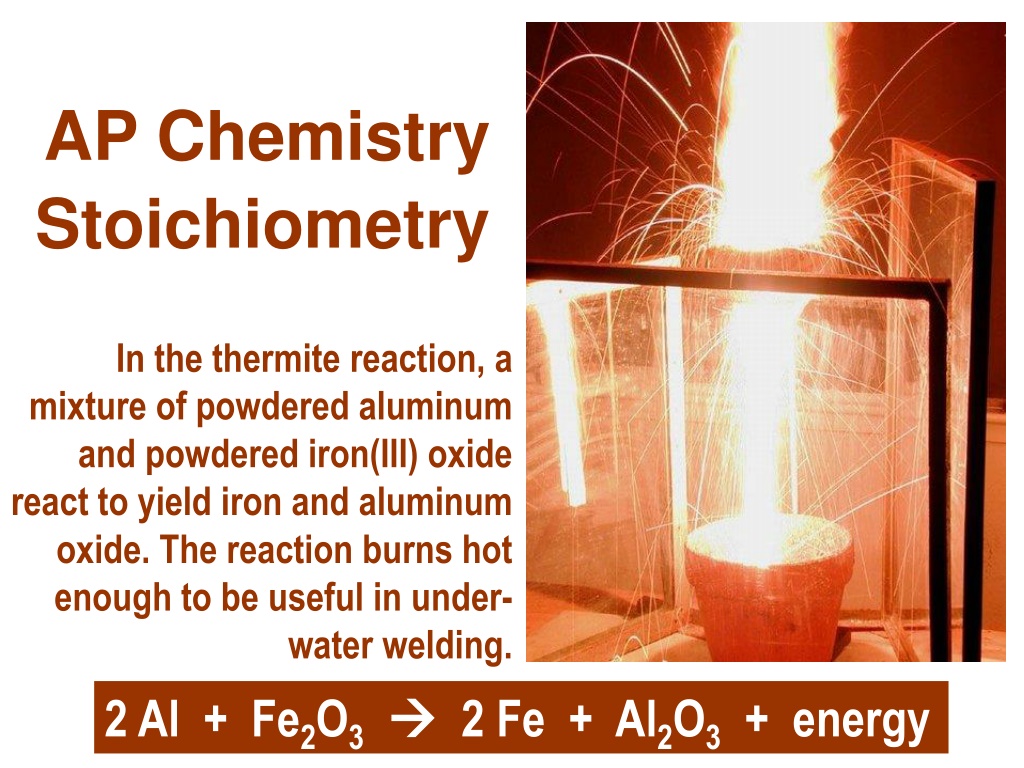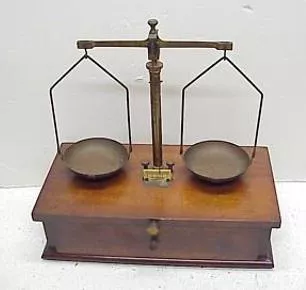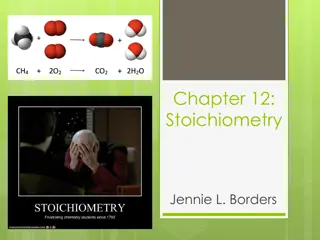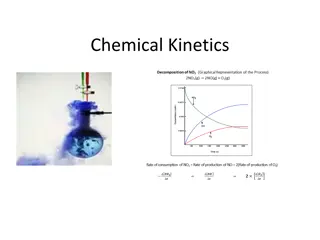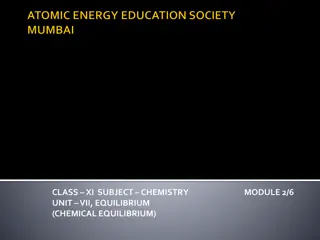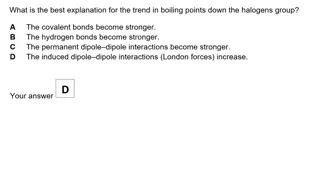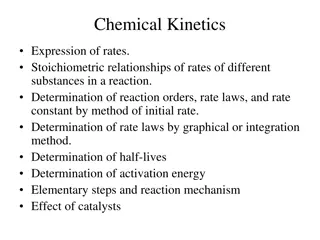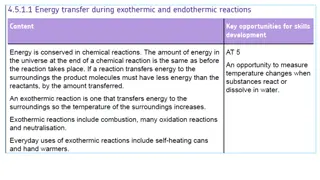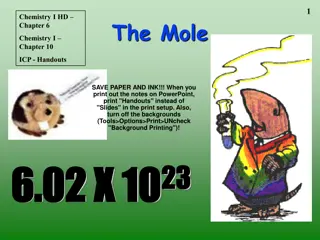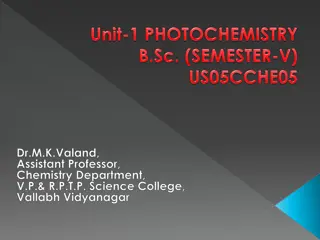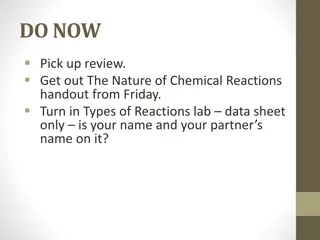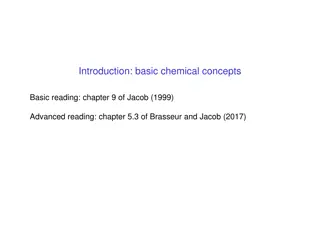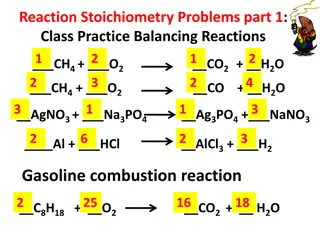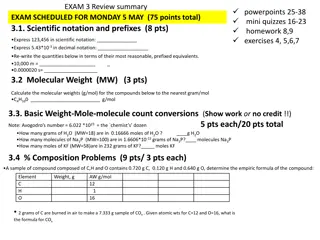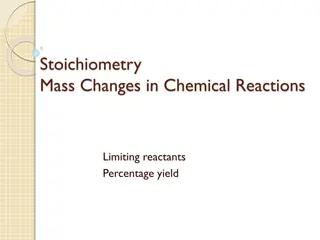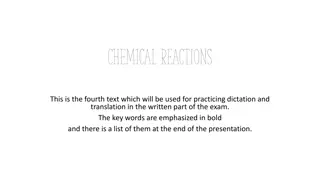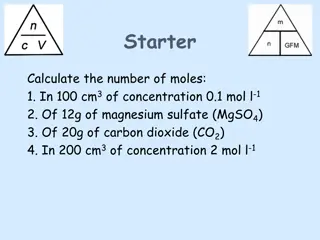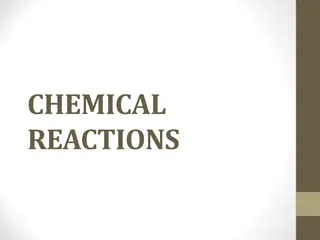Chemical Reactions and Stoichiometry in AP Chemistry
Chemical reactions involving stoichiometry play a crucial role in AP Chemistry. Understanding how atoms are rearranged, mass is conserved, and energy is exchanged is essential for balancing chemical equations. Examples include the thermite reaction, combustion of methane, and reactions like synthesis and decomposition. Balancing equations involves conserving the number of atoms of each type on each side by starting with the most complicated substances. This summary provides insights into various reactions and their balancing in AP Chemistry.
Download Presentation

Please find below an Image/Link to download the presentation.
The content on the website is provided AS IS for your information and personal use only. It may not be sold, licensed, or shared on other websites without obtaining consent from the author.If you encounter any issues during the download, it is possible that the publisher has removed the file from their server.
You are allowed to download the files provided on this website for personal or commercial use, subject to the condition that they are used lawfully. All files are the property of their respective owners.
The content on the website is provided AS IS for your information and personal use only. It may not be sold, licensed, or shared on other websites without obtaining consent from the author.
E N D
Presentation Transcript
AP Chemistry Stoichiometry In the thermite reaction, a mixture of powdered aluminum and powdered iron(III) oxide react to yield iron and aluminum oxide. The reaction burns hot enough to be useful in under- water welding. 2 Fe + Al2O3 + energy 2 Al + Fe2O3
Chemical Equations In a reaction: atoms are rearranged mass energy charge AND are conserved Balancing Chemical Equations law of same # of atoms of each type on each side of equation = conservation of mass Hint: Start with most complicated substances first and leave simplest substances for last.
Solid lithum reacts w/oxygen to form solid lithium oxide. Li+ O2 4 2 Li(s) + O2(g) Li2O(s) + Aqueous aluminum sulfate reacts w/aqueous barium chloride to form a white precipitate of barium sulfate. The other compound remains in solution. Al3+ SO42 Ba2+ Cl Al2(SO4)3 + BaCl2 3 3 2 + AlCl3 BaSO4 (aq) (s) (aq) (aq)
Methane gas (CH4) reacts with oxygen to form carbon dioxide gas and water vapor. Furnaces burn primarily methane. 2 2 CH4(g) + O2(g) H2O(g) CO2(g) + CaC2(s) + H2O(l) C2H2(g) + CaO(s) CaSi2 + SbI3 Si + Sb + CaI2 2 3 6 2 3 Al + CH3OH Al(CH3O)3 + H2 6 3 2 2 3 STOP
4 2 2 C2H2(g) + O2(g) CO2(g) + H2O(l) 5 2 C3H8 + O2 CO2 + H2O 5 3 4 4 8 10 2 5 C4H10 + O2 CO2 + H2O 13 Complete combustion of a hydrocarbon, or of a compound containing C, H, and O (e.g., methanol, CH3OH) yields CO2 and H2O. Another pattern of reactivity: alkali metal metal hydroxide hydrogen gas + water + e.g., 2 Rb(s) + 2 H2O(l) 2 RbOH(aq) + H2(g)
Two (of the several) Types of Reactions combination (synthesis): simpler substances combine to form more complex substances -- form: A + B AB AB + C ABC A + B + C ABC sodium + chlorine gas sodium chloride + 2 2 NaCl Na Cl2
decomposition: complex substances are broken down into simpler ones -- form: AB A + B ABC AB + C ABC A + B + C lithium chlorate lithium chloride + oxygen Li+ Li+ ClO3 Cl 2 3 2 LiCl + O2 LiClO3 water hydrogen gas + oxygen gas 2 2 + O2 H2O H2
SUMMARY: Some Simple Reaction Patterns 1. When we say complete combustion, we mean two things: one, oxygen gas (O2) is a reactant, and two, the other thing(s) is/are entirely consumed (i.e., that O2 is the excess reactant...more on this later). 2. The complete combustion of either a hydrocarbon or or a compound containing only C, H, and O yields the products carbon dioxide (CO2) and water (H2O). 3. Alkali metals (Alk) react with water (H2O) to yield the metal hydroxide (AlkOH) and hydrogen gas (H2). 4. Synthesis reactions begin with simple substances and yield more complex substances; decomposition reactions break complex ones into simpler ones.
formula weight: the mass of all of the atoms in a chemical formula (unit is amu) -- If the substance is a molecular substance (e.g., C3H8), then the term molecular weight is also used. 240px-Close-up_of_mole molar mass: the mass of one mole of a substance (unit is usually grams) -- recall that 1 mole of any substance 6.02 x 1023 particles of that substance =
240px-Close-up_of_mole How Big is a Mole? about the size of a chipmunk, weighing about 5 oz. (140 g), and having a length of about 7 inches (18 cm). BIG. I Meant, How Big is 6.02 x 1023? 6.02 x 1023 marbles would cover the entire Earth (including the oceans) to a depth of 2 miles. 6.02 x 1023 $1 bills stacked face-to-face would stretch from the Sun to Pluto and back 7.5 million times. (It takes light 9,500 years to travel that far.)
The current world population is about 7.5 billion. An average human is made up of about 37 trillion cells. The total number of human cells on Earth is about (7.5 x 109 people) X (37 x 1012 cells/person) = 2.8 x 1023 cells (less than half a mole)
Find the molar mass and formula weight of ammonium phosphate. NH4+ PO43 N:3(14.0 g)= 42.0 g (NH4)3PO4 H: 12(1.0 g)= 12.0 g P: 1 (31.0 g)= 31.0 g O:4 (16.0 g)= 64.0 g m.m. = 149.0 g f.w. = 149.0 amu
percentage composition: the mass % of each element in a compound equation: g element x 100 % of element = molar mass of compound Find the percentage of oxygen, by mass, in calcium nitrate. Ca(NO3)2 6(16.0) % O = = 58.5% O 2(14.0) + 6(16.0) + 40.1 STOP
Empirical Formula and Molecular Formula shows the true number and type of atoms in a m cule lowest-terms formula Empirical Formula Molecular Formula Compound CH2O glucose C6H12O6 C3H8 propane C3H8 C2H5 butane C4H10 C5H4 naphthalene C10H8 C12H22O11 sucrose C12H22O11 C4H9 octane C8H18
Finding an Empirical Formula from Experimental Data 1. Find # of g of each element. 2. Convert each g to mol. 3. Divide each # of mol by the smallest # of mol. 4. Use ratio to find formula.
A ruthenium/sulfur compound is 67.7% Ru. Find its empirical formula. mol 1 Ru 0.670 1 0.670 = 67.7 g Ru mol Ru 101.1 g Ru mol 1 S 0.670 1.5 1.006 = 32.3 g S mol S 32.1 g S RuS1.5 Ru2S3
A sample of a compound contains 4.63 g lead, 1.25 g nitrogen, and 2.87 g oxygen. Name the compound. mol 1 Pb 0.0223 1 0.0223 = 4.63 g Pb mol Pb 207.2 g Pb mol 1 N 0.0893 = 4 0.0223 1.25 g N mol N 14.0 g N mol 1 O 0.0223 8 0.1794 = 2.87 g O mol O 16.0 g O ? PbN4O8 Pb(NO2)4 Pb? 4 NO2 ? lead(IV) nitrite STOP
To find molecular formula A. Find empirical formula. B. Find molar mass of empirical formula. C. Find n = mm molecular mm empirical D. Multiply all parts of empirical formula by n. (How many empiricals fit into the molecular?)
A sample of a compound has 26.33 g nitrogen, 60.20 g oxygen, and molar mass 92 g. Find molecular formula. mol 1 N 1.881 1 1.881 = 26.33 g N mol N 14.0 g N mol 1 O 1.881 2 3.763 = 60.20 g O mol O 16.0 g O NO2 92 g 46 g mmemp =46 g N2O4 = 2 STOP
Hydrates and Anhydrous Salts anhydrous salt: an ionic compound (i.e., a salt) that attracts water molecules and forms weak chemical bonds with them; symbolized by MN anhydrous = without water Same idea as with desiccants in leather goods, electronics, vitamins hydrate: an anhydrous salt with the water attached -- symbolized by MN .? H2O Examples: CoCl2. 6 H2O Na2CO3. 10 H2O FeCl3. 6 H2O BaCl2. 2 H2O
H2O H2O H2O H2O H2O HEAT H2O H2O MN H2O hydrate MN + H2O H2O H2O H2O anhydrous salt water ENERGY + ENERGY +
Finding the Formula of a Hydrate 1. Find the # of g of MN and # of g of H2O. 2. Convert g to mol. 3. Divide each # of mol by the smallest # of mol. 4. Use the ratio to find the hydrate s formula.
Strontium chloride is an anhydrous salt on which the following data were collected. Find formula of hydrate. beaker = 65.2 g beaker + sample before heating = 187.9 g beaker + sample after heating = 138.2 g Sr2+Cl beaker + salt + water chewbacca chewbacca beaker + salt SrCl2 mol 1 MN 0.46 1 0.46 = 73.0 g MN mol MN 158.6 18 g H MN O 2 mol 1 0.46 2.76 = 6 mol H O 49.7 g H O 2 2 g H O 2 SrCl2. 6 H2O STOP
Converting Between Various Units 1 mol = molar mass (in g) Mass (g) 1 mol = 22.4 L Volume (L or dm3) MOLE (mol) 1 mol = 22.4 dm3 (For gases only!) at STP Particle (at. or m c) 1 mol = 6.02 x 1023 particles One-Substance Island Diagram
aluminum sulfate What mass is 6.29 x 1024m cules ? Al3+ Al2(SO4)3 342.3 g ) SO42 ( ( ) 1 mol 6.02 x 1023m c 6.29 x 1024m c 1 mol = 3580 g At STP, how many g is 87.3 dm3 of nitrogen gas? N2 87.3 L( ) ( ) 1 mol 28.0 g = 109 g 22.4 L 1 mol STOP
Mass (g) 1 mol = 22.4 L Volume (L or dm3) MOLE (mol) 1 mol = 22.4 dm3 Particle (at. or m c)
When going from moles of one substance to moles of another, use the coefficients from the balanced equation. SUBSTANCE B (unknown) SUBSTANCE A (known)
Straight Stoichiometry (no funny business) -- the quantity of only one substance is given -- for gases, the conditions are STP How many moles oxygen will react with 16.8 moles sodium? 4 Na + O2 2 Na2O Na O2 ( ) 1 mol O2 16.8 mol Na = 4.20 mol O2 4 mol Na
At STP, how many molecules of oxygen react with 632 dm3 butane (C4H10)? butane C4H10 oxygen O2 __ C4H10 + __ O2 1 2 __ CO2 + __ H2O 4 8 5 10 13 ( ) 6.02 x 1023m c O2 ( ) ( ) 1 mol C4H10 22.4 dm3 C4H10 13 mol O2 632 dm3 C4H10 1 mol O2 2 mol C4H10 = 1.10 x 1026m c O2 Suppose the question had been how many ATOMS of O 1.10 x 1026m c O2( 1 m c O2 ) 2 atoms O = 2.20 x 1026 at. O
How many grams potassium will react with 465 grams nickel(II) phosphide? Ni2+ P3 Ni3P2 nickel(II) phosphide potassium K 6 K + Ni3P2 ( 238.1 g Ni3P2 Ni + K3P ) 1 mol Ni3P2 3 2 ( ) ( ) 1 mol Ni3P2 6 mol K 465 g Ni3P2 39.1 g K 1 mol K = 458 g K STOP
1 mol = 22.4 L 1 mol = 22.4 L COEFFS FROM MOLE (mol) MOLE (mol) 1 mol = 22.4 dm3 1 mol = 22.4 dm3 BALANCED EQ. Particle (at. or m c
Limiting Reactants (a.k.a., Limiting Reagents) limiting reactant (LR): the reactant that runs out first -- Amount of EVERYTHING depends on the LR. Any reactant you don t run out of is an excess reactant (ER).
How to Find the Limiting Reactant For the generic reaction RA + RB P, assume that the amounts of RA and RB are given. Should you use RA or RB in your calculations? 1. Calc. # of mol of RA and RB you have. 2. Divide by the respective coefficients in balanced equation. 3. Reactant having the smaller result is the LR.
2 H2(g) + O2(g) 2 H2O(g) 13 g H2 80. g O2 How many g H2O are formed? 13 g H2( 80 g O2( ) )= 2.5 mol O2 (HAVE) . _. 1 mol H2 2 g H2 = 3.25 = 6.5 mol H2 (HAVE) 2 LR = O2 . _. 1 = 2.50 1 mol O2 32 g O2 Oh, bee- HAVE ! (And start every calc. with the LR.) O2 H2O 1 mol H2O ( ) ( ) 2 mol H2O 18 g H2O 2.5 mol O2 = 90. g H2O 1 mol O2
2 Fe(s) + 3 Cl2(g) 2 FeCl3(s) 223 g Fe 179 L Cl2 At STP, what is the limiting reactant? 223 g Fe( ) (HAVE) 179 L Cl2( )= 8.0 mol Cl2 (HAVE) . _. LR = Fe 1 mol Fe 55.8 g Fe = 2.0 = 4.0 mol Fe 2 . _. 3 = 2.66 1 mol Cl2 22.4 L Cl2 What mass of FeCl3 is produced? ( Oh, bee-HAVE! ) Fe FeCl3 ( ) ( ) 2 mol FeCl3 162.3 g FeCl3 = 649 g FeCl3 4.0 mol Fe 1 mol FeCl3 2 mol Fe STOP
Theoretical Yield, Actual Yield, and Percent Yield The amount of product we get if the reaction is perfect is called the theoretical yield. -- It is found by calculation. If we ACTUALLY DO the reaction and measure the actual yield, we will find that this amount is less than the theoretical yield (i.e., % yield can never be > 100%). actual yield = yield % x 100 theoretica yield l Highest career BA: Ty Cobb, .366 Highest career FT%: Mark Price, .904
ZnS + O2 ZnO + SO2 100. g 100. g 100 g ZnS( ) (HAVE) 1 mol 32 g )= 3.125 mol O2 (HAVE) 2 3 2 2 X g Assume 81% yield. . _. = 0.513 LR 1 mol 97.5 g = 1.026 mol ZnS 2 100 g O2( . _. 3 = 1.042 ZnS ZnO ( ) ( ) 2 mol ZnO 81.4 g ZnO 1.026 mol ZnS = 83.5 g ZnO 1 mol ZnO 2 mol ZnS Actual g ZnO = 83.5 (0.81) = 68 g ZnO
Automobile air bags inflate with nitrogen via the decomposition of sodium azide: 2 NaN3(s) 3 N2(g) + 2 Na(s) At STP and a % yield of 85%, what mass sodium azide is needed to yield 74 L nitrogen? % yld = actual theo NaN3 N2 0.85 = 74 L N2 theo L N2 theo = 74 L N2 = 87.1 L N2 0.85 ( ) 1 mol NaN3 ( ) 87.1 L N2( STOP ) 1 mol N2 22.4 L N2 2 mol NaN3 65 g NaN3 = 170 g NaN3 3 mol N2
